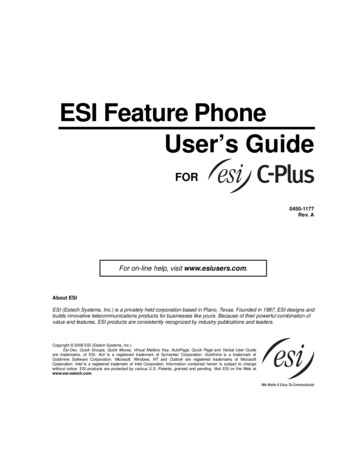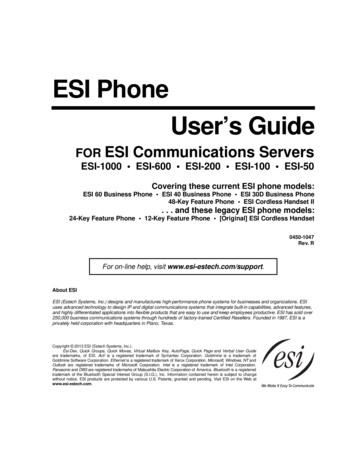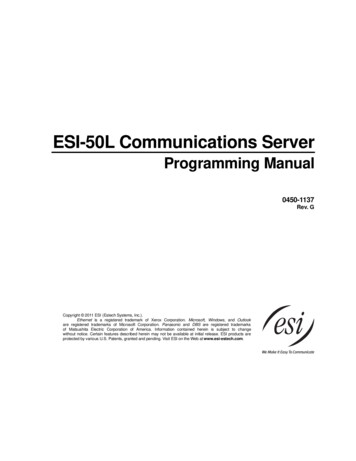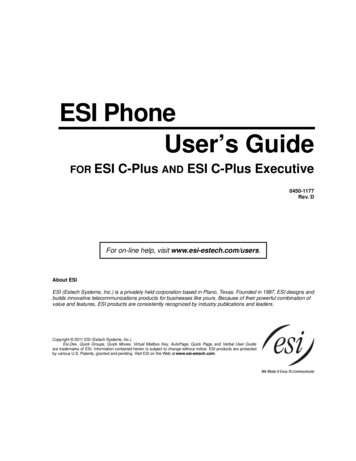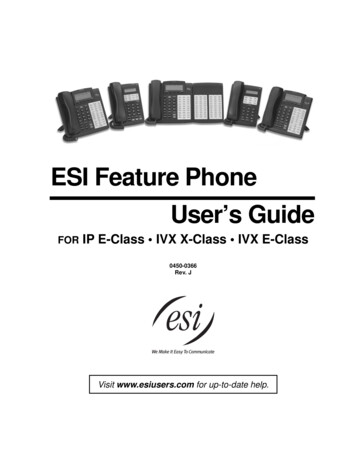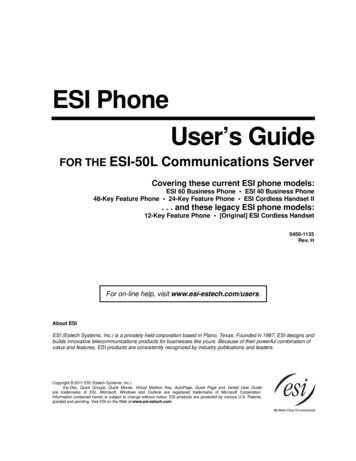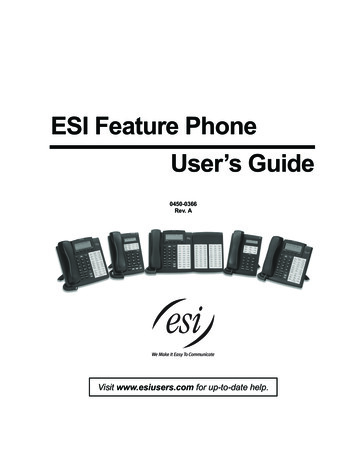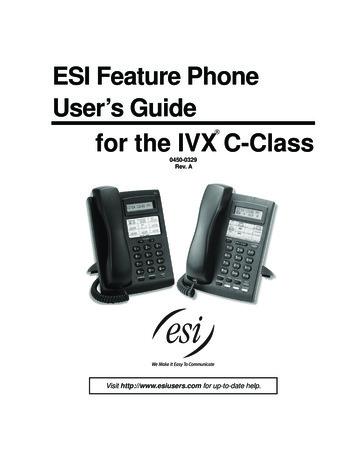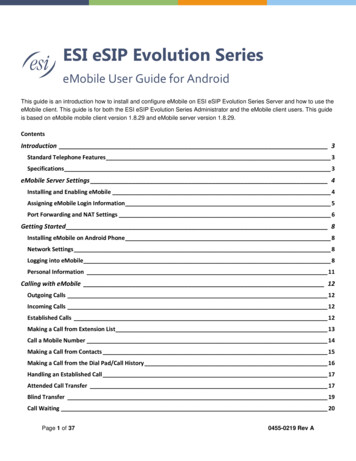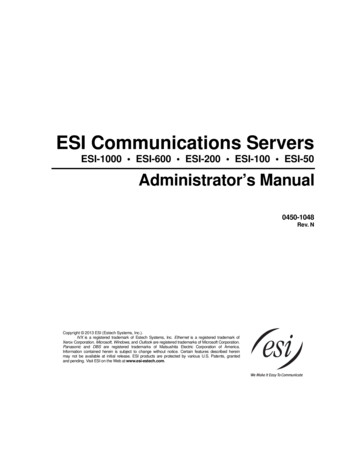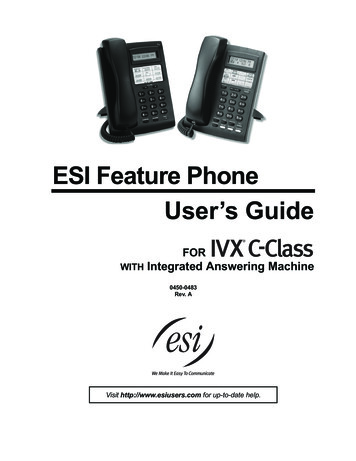
Transcription
ESI Feature PhoneUser’s GuideFORWITHIntegrated Answering Machine0450-0483Rev. AVisit http://www.esiusers.com for up-to-date help.
About ESIESI (Estech Systems, Inc.) is a privately held corporation based in Plano, Texas, near the internationallyknown “Telecom Corridor.” Founded in 1987, ESI designs and builds innovative telecommunicationsproducts for businesses like yours. Because of their powerful combination of value and features,ESI products are consistently recognized by industry publications and leaders.Copyright 2003 ESI (Estech Systems, Inc.).Visit ESI on the Web at http://www.esi-estech.com.Microsoft is a registered trademark of Microsoft Corporation. Intel is a registered trademark of Intel Corporation. Certain ESI products are protected byU.S. Patents No. 6,067,349 and 6,252,944, and others pending. Product information contained herein is subject to change without notice. ESI is anISO 9001-certified company.
Table of contentsIntroduction.A.124-Key Feature Phone .A.212-Key Feature Phone .A.3Connecting your ESI phone .A.4Help mode (Verbal User Guide) .B.1User programming: An introduction.C.1User programming menu .C.1Integrated Answering Machine operation .D.1Introduction .D.1Greetings .D.1Leaving messages . . .D.2Off-premises “reach me”.D.2Message retrieval.D.2Off-premises message delivery .D.5Message Recycle Bin (un-delete).D.6Status Indicator lamp .D.6ESI Feature Phone operation.E.1Display.E.1Caller ID .E.1Keys.E.1Dial tone .E.3Basic phone use.E.3Direct station selection.E.4Transferring an outside call . . . .E.5Conference calling .E.6Call forwarding.E.6Call waiting.E.7Hold/exclusive hold operation .E.8Paging .E.10Call pickup .E.10Optional feature.E.10Special keys. F.1Esi-Dex. F.1Override ring . F.4Message monitor mode (live call screening) . F.4Greeting reminder . F.5Headset operation. F.5Outside dial tone preference . F.5Line keys. F.6Optional features . F.6Analog stations . G.1Placing calls. G.1Transferring calls . G.1Call forwarding. G.2Call waiting. G.2Call hold . G.2Paging . G.2Call pick-up . G.3Voice mail operation from an analog station. G.3Analog station programming . G.5Select greeting. G.5Password . G.5Off-premises message delivery . G.6Message Recycle Bin (un-delete). G.7Index
(This page included for pagination purposes only.)
User’s GuideIntroductionIntroductionAccessing the rich ESI feature set is simple and easy through the straightforward design of ESI’sFeature Phones. Each feature has been designed for ease of use while providing capabilities needed inan advanced business phone. As for the IVX C-Class phone system itself, its Integrated AnsweringMachine functions like a traditional answering machine but with additional, special features.You will be able to learn many of the features by simply using your phone; and this IVX C-Class User’sGuide will introduce you to the wide variety of features offered by your ESI phone system and how touse your phone effectively to achieve maximum benefits.What it covers 24-Key Feature Phone 12-Key Feature PhoneHow it’s arranged Section A — Introduction and phone illustrations Section B — User help Section C — User programming Section D — Integrated Answering Machine operation Section E — Phone operation Section F — Special keys and features Section G — Analog stations IndexA.1
IntroductionUser’s Guide24-Key Feature PhoneThe 24-Key Feature Phone has a variety of programmable and built-in features. The 24-Key FeaturePhone’s built-in voice mail features and voice prompts make it easy to program and use.Volume/scroll keysStatus indicator light (pg. D.6)2-line, 32-character displayESI-DEX feature key(pg. F.1)12 programmable featurekeys (pg. C.2)SpeakerVOICE MAIL feature key(pg. D.1)P/UP (pickup) key(pg. E.10)PAGE key (pg. E.10)PROG/HELPfeature keyfor phone programmingas well as accessto Verbal User’s Guideand tutorial (pg. B.1)RECORD fixed feature keyMicrophone forbuilt-in speakerphoneFxed feature keys(pg. E.1)Hint:A.2You can perform direct programming by holding down a programmable feature key for at leasttwo seconds (similar to how you might program a car radio button). This isn’t applicable to thefixed feature keys.
User’s GuideIntroduction12-Key Feature PhoneThe 12-Key Feature Phone includes the basic, most commonly used phone features.Volume/scroll keys1-line,16-character displaySpeaker9 programmablefeature keysP/UP (pickup) key(pg. E.10)PROG/HELPfeature keyfor phone programmingas well as accessto Verbal User’s Guideand tutorial (pg. B.1)PAGE key (pg. E.10)Fxed feature keys(pg. E.1)Notes: The following features are not available on the 12-Key Feature Phone. Certain special features; see page F.6. Esi-Dex.A mailbox key, CONFERENCE key, and MUTE/DND key must be set on one of the nineprogrammable feature keys to utilize those features.Hint:You can perform direct programming by holding down a programmable feature key for at leasttwo seconds (similar to how you might program a car radio button). This isn’t applicable to thefixed feature keys.A.3
IntroductionUser’s GuideConnecting your ESI phoneUse the diagram (below) to connect your ESI phone. The diagram represents the panel on thephone’s underside.Note: The “Top of phone” and “Bottom of phone” references in this diagram shows the correct verticalorientation of the phone — i.e., the part with the display is the top.HandsetLine cordto wallA.412-Key Feature Phone24-Key Feature Phone Connects like a basic phone. Handset plugs into right-side jack. Line cord plugs into left-side jack.
User’s GuideHelp mode (Verbal User Guide)Help mode (Verbal User Guide)Your ESI phone system’s Help mode (also called the Verbal User Guide) — a carefully conceivedcombination of spoken information, display readouts and even key illumination when appropriate — is apowerful tool to help you learn how to use the system’s many features.TutorialWhen your station is idle, press PROG/HELP, and then follow the spoken Help menu to: Learn how to use the phone Hear a description of how any key is used Learn how to use voice mail features Hear a complete tutorial on phone operationHelp during station programmingTo hear a detailed description of a function you wish to program, press PROG/HELP while programming it.Help during a callPress PROG/HELP while on a call and this will place the call on hold, whereupon you can use Helpmode to hear a description of the function you wish to perform. When you exit Help mode, you will bereconnected to the call.While you are either in Help mode or programming your phone, your station will be temporarily placed inDND (see “MUTE/DND,” page E.2). Anyone calling your station while you are in DND will be forwardedto the Integrated Answering Machine.Exiting Help modeTo exit Help mode, simply hang up.Visit www.esiusers.com for up-to-date help.B.1
Help mode (Verbal User Guide)User’s Guide(This page included for pagination purposes only.)B.2
User’s GuideUser programming: An introductionUser programming: An introductionThe answering machine can record up to two simultaneous calls. When a message is left, a key willlight up: on a 24-Key Feature Phone, it’ll be the VOICE MAIL key; on a 12-Key Feature Phone, it’ll be aprogrammable feature key (see “Programmable feature keys,” p. C.2) programmed for Mailbox 501.Messages can be retrieved by any authorized 12 or 24-Key Feature Phone or remotely from an offpremises location. Only one user can access the mailbox at a time. The system can also beprogrammed to call an off-premises number to deliver messages.The first member in the list is allowed to program the Integrated Answering Machine via the PROG/HELPkey. This station is designated as the Master Station. All other users can only play and delete messages.Either a 24- or 12-Key Feature Phone can be installed on an extension in the member list. However, a24-Key Feature Phone must be on the extension designated as the Master Station.Voice prompts will play menu and sub-menu options to access the desired feature. You don't have to waitfor the entire prompt to be played. Therefore, once you’ve become familiar with the prompts (see “Userprogramming menu,” below), you can quickly set any frequently used feature.Programming helpDuring any of the programming steps, press PROG/HELP to hear a more detailed description of thefeature and related programming options.Exiting programming modeTo exit programming mode, simply hang up.User programming menuOverviewNote: Only the menu options 2, 3, and 4 (except for Personal greeting reminder) are available tonon-Master users.1 Select personal greeting1 Record2 Delete3 Hear4 Station audibles1 Station ring tone2 Station ring volume3 Message ring2 Programmable feature keys(Station keys, line keys, speed-dial keys,other feature keys)5 Password1 Enter2 Delete3 Hear4 Security level3 Station options1 Call waiting/background announce2 Personal greeting reminder3 Headset operation4 Outside dial tone preference5 Hands-free answer6 Message monitor6 External message notification1 Delivery options2 Phone delivery3 Pager notification9 Message Recycle BinNote: Background announce and selections 3, 5, and 6 under Station Options are not available on a 12 KeyFeature Phone.C.1
User programming: An introductionUser’s Guide1 Select personal greetingSelect the desired greeting — 1, 2 or 3. The system will play the current greeting, followed byprompts to re-record, delete or hear again — or select the current greeting by pressing #.1Record personal greetingBegin recording at the tone. Press 1 to stop. The new personal greeting automatically replacesthe previous greeting.2Delete personal greetingWhen prompted, press 2 again to confirm deletion.Warning:The mailbox is disabled if no greeting exists. Never delete all of the existing greetings beforeyou record at least one new one.3 Hear current personal greeting2 Programmable feature keysThere are two methods for programming your phone: Direct programming — Select the key you want to program, and hold it down for at least twoseconds. This not only initiates programming but also lets you immediately program that specific key. Traditional programming — Press PROG/HELP. The Verbal User Guide will speak to you,walking you through the full menu, during which you can choose the appropriate option.Direct programming example:You wish to set one of the keys to dial a co-worker, whose extension is 105. Hold down the keyfor at least two seconds. This automatically puts you in feature key programming. Follow theprompts to enter 1 0 5. (This has allowed you to skip two steps — pressing PROG/HELP andselecting a menu option — that you’d have had to perform if using traditional programming.)How the programmable feature keys can be set Line keys — If a line number (1 through 12) is programmed, the programmable feature keybecomes a line key providing the appropriate lamp information and manual outside-line access. Station keys — If the dialed digits input are a three-digit number, the programmable feature keywill become a Station Key providing the appropriate lamp information and easy access ortransfer. Three-digit numbers input can be:– User extensions (100–123)– Department numbers (290–299)– System speed-dial numbers (600–699) Speed-dial keys — In addition to programming a programmable feature key with a systemspeed-dial number, you can create personal speed-dial keys for automatic dialing of frequentlycalled outside numbers. If you program 9 (or 8 or 7) plus a phone number, the programmablefeature key becomes a speed-dial key. When you program a speed-dial key, there's no need toinsert a pause after the 9 (or 8 or 7). The speed-dial number can be up to 24 characters long.Use the up scroll key ( ) to enter special characters in a dial string (see Option 6 on page C.4). Other feature keys — If you enter feature codes, the programmable feature key will serve as anenable/disable key for that feature. The Installer may have programmed certain stations foraccessing additional features; consult your System Administrator for your access (see page F.6).C.2
User’s GuideUser programming: An introductionKeys’ LED activity during programmingKey type and LED indicationStation key orVirtual Mailbox KeyLine keyFeature keyor speed-dial keyCurrently being programmed andpreviously assignedFlashing redFlashing greenFlashing amberCurrently being programmed andpreviously unassignedFlashing redFlashing redFlashing redProgramming mode — Was assigned orviewed in current sessionBlinking redBlinking greenBlinking amberAssigned in a previous programmingsession and not yet viewed incurrent sessionSolid redSolid greenSolid amberNever assigned and not yet viewed incurrent sessionOffOffOffMode3 Station optionsThe station options sub-menu (PROG/HELP 3) lets you activate or deactivate several featuresyour station can provide. At each option sub-menu, 1 enables the option and 0 disables it. (Eachoption listed below is explained elsewhere in this manual, as noted.)1Call waiting/Background announceSee page E.7 for call waiting and page E.8 for background announce.2Greeting reminder (Master station only)See page F.5.3Headset operation1See page F.5.4Outside dial tone preferenceSee page F.5.5Hands-free answerSee page E.2.6Message monitorSee page F.4.Note: Background announce and selections 3, 5, and 6 are not available on a 12-Key Feature Phone.1Not available on the 12-Key Feature Phone.C.3
User programming: An introductionUser’s Guide4 Station audiblesThe station audibles programming provides control of the following audible items:1Station ring toneYou can select from six possible tones to help distinguish it from other nearby ringing phones.Press or to select a tone, then press # to accept it.2Station ring volumePress and to set the desired ringer volume (range: off to high), then press # to accept it.3Message ringWhen enabled, this feature will periodically generate a short ring tone at your station as anadditional alert that you have new messages.5 Password1Enter new passwordYour password may consist of 2–8 digits followed by # (0 cannot be the first digit). Entering only0 as the password will turn off the password requirement.2Delete current passwordResets the password to the default password.3Hear current passwordDisplays and plays back the current password.4Password security levelSelectionResult0No password required for access from any phone1Password required only for remote access, either off-premises or from other stationswithin the system2Password always required6 External message notification1Delivery options1Delivery to phone number only2Notify pager only0No off-premises delivery(Continued)C.4
User’s GuideUser programming: An introduction2 Phone delivery1Enter phone numberEnter the phone number (24 digits, maximum) followed by #. Do not include an outside lineaccess code (i.e., don’t add 9, 8, or 7) before the number.To insert a special character, press the right scroll key ( ) to select the desired specialcode: # , , F, or P. Press # to confirm the inserted character and continue. Use thedown arrow key ( ) to backspace. Press # # to complete the entry.Code#FPWhat it produces# DTMF toneDTMF toneFlash hook2-second pauseOnce the number is saved you can use the scroll keys to move back and forth to view thenumber. To edit the number, you must delete it and enter the correct number.32Delete phone numberDeletes the currently programmed phone number.3Display current phone numberDisplays the currently programmed phone number.Pager notification1Enter pager numberEnter the pager number (24 digits, maximum) followed by #. Do not include an outside lineaccess code (i.e., don’t add 9, 8, or 7) before the number.To insert a special character, press the right scroll key ( ) to select the desired specialcode: # , , F, or P. Press # to confirm the inserted character and continue. Use thedown arrow key ( ) to backspace. Press # # to complete the entry.Code#FPWhat it produces# DTMF toneDTMF toneFlash hook2-second pauseOnce the number is saved you can use the scroll keys to move back and forth to view thenumber. To edit the number, you must delete it and enter the correct number.2Delete pager numberDeletes the currently programmed pager number.3Display current pager numberDisplays the currently programmed pager number.9 Message Recycle Bin (un-delete)The 10 most recently deleted messages will be played first. Press 9 to move to the next message.Press 8 to restore the message to Mailbox 501 as an old message.C.5
User programming: An introduction(This page included for pagination purposes only.)C.6User’s Guide
User’s GuideIntegrated Answering Machine operationIntegrated Answering Machine operationIntroductionYour phone system provides accurate and timely messages. Others will become more comfortableleaving you voice messages if you promptly retrieve and respond to your messages.VOICE MAIL keyThe VOICE MAIL key is used for direct access to voice mail features.Warning:On stations with a 12-Key Feature Phone, a programmable feature key must be set to code579 (for VOICE MAIL key). If a key is not programmed to 579, you will still be able to retrievepreviously left messages and access user programming, but you will not be able to receivenew messages (when you access the mailbox, the phone system will announce that themailbox is disabled). Program 579 on a programmable feature key to enable the mailbox.GreetingsNote: Greetings are for use by only the Master Station.Initially, the mailbox has a generic greeting: “You have reached mailbox 501. Dial 0 to reach theoperator or begin recording at the tone.” You can record up to three different greetings in your own voiceindicating your availability to return calls. Also, you can change any greeting as often as necessary, byjust recording over a previously recorded greeting.Warning: Do not delete all of the greetings; make sure at least one always remains. Deleting all thegreetings will turn off the mailbox.ExamplesSample greeting 1: Hello; thank you for calling [company name]. We are currently assisting other customers.Please dial zero to reach our operator or leave your name, number, and message at thetone, and we will get back to you as soon as we can.Sample greeting 2: Hello; thank you for calling [company name]. We are currently out of the office. To attemptto reach our mobile phone, please press four now. Otherwise leave your name, number,and message at the tone, and we will get back to you as soon as we can.Sample greeting 3: Hello; thank you for calling [company name]. We are currently out of the office. Pleaseleave your name, number, and message at the tone, and we will get back to you as soonas we can.Depending on your company’s preferences, you may wish to include one or more of these options inyour greetings:Option014XXXInstructionTo reach the operatorTo skip directly to the record tone (or “beep”)To perform off-premises “reach-me” (see “Off-premises ‘reach-me,’” page D.2)An extension number of another userNote: Option 4 is available only when Greeting 2 has been recorded (see “Off-premises ‘reachme,’” page D.2).D.1
Integrated Answering Machine operationUser’s GuideGreeting keysYou can program a programmable feature key as a greeting key for any one of the three greetings (seepage F.7). Once created, this shortcut can then be used to activate the associated greeting (the key’sLED will glow green and the greeting played as confirmation).Note: On a 24-Key Feature Phone, press RECORD while the confirmation is playing and follow the promptsto record the greeting. Otherwise, listen to the greeting to the end and follow the prompts.Leaving messages . . .If you call another station that is DND, busy, or does not answer, you will be transferred to the mailbox.You can skip the greeting by pressing 1; this takes you directly to the record tone. . . directly in the mailboxThe procedure for going directly to the mailbox without ringing an extension depends upon whether youhave the mailbox (501) set as one of your station keys: If you do, press VOICE MAIL and then the MB 501 station key. If you don’t, press VOICE MAIL and TRANSFER and then dial the mailbox number (501)Either will connect you directly to the mailbox greeting.Off-premises “reach me”After a caller has been forwarded to the mailbox and is listening to the greeting, this feature allows thecaller to be forwarded to a number outside the system — i.e., a regular phone number rather than anextension. You must have greeting
Introduction User’s Guide A.4 Connecting your ESI phone Use the diagram (below) to connect your ESI phone. The diagram represents the panel on the phone’s underside. Note: The “Top of phone” and “Bottom of phone” references in this diagram shows the correct vertical orientation of the phone — i.e., t
